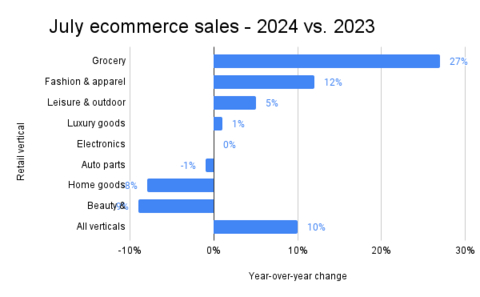The heart of the back-to-school shopping season reportedly saw consumers shift their online spending to lower-cost items and alternatives, signaling that economic stressors might have translated into a cautionary tale for consumers, according to e-commerce data released by Signifyd, an e-commerce fraud protection platform.
Key findings from Signifyd’s July E-commerce Pulse Data include:
- Online spending continued to grow annually in July, but the fastest growth was in orders under $100. Meanwhile, purchases above $500 were nearly flat year-over-year.
- Clues to the health of the upcoming Holiday shopping season remain elusive. Overall, online spending is up 10 percent annually, but growth was powered by discounts and consumers trading down for less expensive merchandise.
- Average order value was down 4 percent compared to July 2023, signaling caution among consumers.

Are Consumers Becoming Fatigued?
“What we saw in July was not surprising given recent macroeconomic trends,” Signifyd CEO Raj Ramanand said. “Online retail remains healthy, but, clearly, economic uncertainty and the decline in surplus savings are weighing on consumers. We’ve entered an era during which merchants need to focus on profitable growth rather than growth at any cost. This is the time for brands to develop lasting customer value by doubling down on the long-term relationships they build with the customers they serve.”
Signifyd suggests that retailers who focus on the long game will have an opportunity to compensate for smaller cart sizes by encouraging customers to return over the long haul.
E-Commerce Sales July 2024 versus July 2023
- Grocery, up 27 percent
- Fashion & Apparel, up 12 percent
- Leisure & Outdoor, up 5 percent
- Luxury Goods, up 1 percent
- Electronics, 0 percent
- Auto Parts, down, 1 percent
- Home Goods, down 8 percent
- Beauty & Cosmetics, down 9 percent
- All Verticals, up 10 percent
Consumers Trading Down in an Uncertain Economy
“The decline in average order value is somewhat worrisome,” said Signifyd’s Senior Data Analyst, Phelim Killough. “Add to that the fact that cart size, or the number of items per order, was down 9 percent, and it’s a less-than-glowing report. Higher overall spending, lower average order value and smaller cart sizes tell the story of consumers who are trading down and finding cheaper options for the things they need.”
A look at how consumers spent their money in July underscores Killough’s analysis. Overall, Signifyd found that the number of e-commerce orders “increased by 15 percent in July compared to a year ago.” Lower-cost purchases reportedly drove the growth. Breaking down average spending per order into $100 increments, Signifyd found that orders under $100 increased 17.7 percent compared to July 2023. Conversely, orders over $500 rose only 1.5 percent over a year ago.
Signifyd noted that “economists have been warning that consumer spending, a growth engine that has been roaring since the end of the pandemic, could not run at turbo speed forever. Record savings, bolstered by pandemic stimulus payments, are dwindling, and strong employment growth dipped in July, briefly panicking equity markets.”
Signifyd, reflecting on the nature of the overall economy, found that consumers spent “robustly in some retail verticals in July while pulling back in others.” Traditional back-to-school (BTS) and back-to-college verticals were a mixed bag. Apparel spending was up 12 percent over a year ago, while electronics remained flat and home goods spending dropped 8 percent.
BTS Shopping Surfaces Wants and Needs
Discounts played a role in back-to-school shopping this year, with “wants” and “needs” in focus. The average applied discount in the electronics category was 12 percent. Fashion shoppers enjoyed an average discount of 22 percent, about the same as 2023. Home goods discounts averaged nearly 29 percent or 3 percent higher than a year ago, but even those deals were not enough to spur consumers to accelerate home goods spending higher than last July.
The average discount for all transactions across Signifyd’s entire commerce network of “thousands of retailers” was 23.5 percent, a 3 percent increase from discounts applied in July 2023.
Grocery Spending Increased while Beauty and Cosmetics Spending Declined
Other verticals that saw notable annual sales fluctuations in July include grocery, leisure and outdoor and luxury goods. Grocery spending continued a trend that started in the spring, increasing 27 percent annually. Again, in July, the rise in spending was driven by volume, not price increases. Auto parts, beauty and cosmetics declined year-over-year, down 1 percent and 9 percent, respectively.
Methodology
Signifyd’s E-commerce Pulse data is derived from transactions on the company’s Commerce Network of e-commerce retailers and brands. Commerce Network intelligence also powers Signifyd’s Commerce Protection Platform, which leverages AI-driven machine learning models and data from billions of transactions to detect and block fraudulent activity while increasing the number of good orders approved. Signifyd has seen over 600 million unique shopper wallets globally, meaning that 98 percent of the time, when a shopper comes to a Signifyd-protected site, Signifyd’s machine-learning models recognize the shopper instantly.
Data courtesy Signifyd














